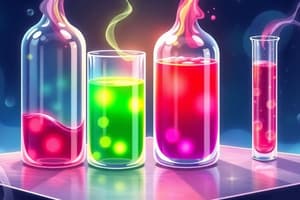Podcast
Questions and Answers
How can red litmus paper help identify acidic and basic solutions?
How can red litmus paper help identify acidic and basic solutions?
Red litmus paper turns blue in basic solutions and remains red in acidic solutions.
What is the role of olfactory indicators in identifying acids and bases?
What is the role of olfactory indicators in identifying acids and bases?
Olfactory indicators change their odor in acidic or basic environments, providing a different method for identification.
What color change occurs in blue litmus paper when exposed to an acidic solution?
What color change occurs in blue litmus paper when exposed to an acidic solution?
Blue litmus paper turns red in acidic solutions.
In the activity with onion cloth strips, how does HCl affect the odor compared to NaOH?
In the activity with onion cloth strips, how does HCl affect the odor compared to NaOH?
Describe the change observed with phenolphthalein when introduced to a basic solution.
Describe the change observed with phenolphthalein when introduced to a basic solution.
What observations would you record when testing acetic acid with methyl orange?
What observations would you record when testing acetic acid with methyl orange?
What happens to the litmus paper when testing a neutral solution like distilled water?
What happens to the litmus paper when testing a neutral solution like distilled water?
What is the significance of observing color changes in indicators during acid-base testing?
What is the significance of observing color changes in indicators during acid-base testing?
How might one use sodium hydroxide (NaOH) to confirm the presence of an acid?
How might one use sodium hydroxide (NaOH) to confirm the presence of an acid?
What can be inferred if a solution turns methyl orange from yellow to red?
What can be inferred if a solution turns methyl orange from yellow to red?
Flashcards
Indicators
Indicators
Substances that change color in acidic or basic solutions. Examples include litmus paper, phenolphthalein, and methyl orange.
Olfactory Indicators
Olfactory Indicators
Indicators that change their odor when exposed to acids or bases.
Litmus Paper
Litmus Paper
A type of indicator that turns red in acidic solutions and blue in basic solutions.
Phenolphthalein
Phenolphthalein
Signup and view all the flashcards
Methyl Orange
Methyl Orange
Signup and view all the flashcards
Hydrochloric Acid (HCl)
Hydrochloric Acid (HCl)
Signup and view all the flashcards
Sodium Hydroxide (NaOH)
Sodium Hydroxide (NaOH)
Signup and view all the flashcards
Acetic Acid (CH3COOH)
Acetic Acid (CH3COOH)
Signup and view all the flashcards
Ammonium Hydroxide (NH4OH)
Ammonium Hydroxide (NH4OH)
Signup and view all the flashcards
Calcium Hydroxide [Ca(OH)2]
Calcium Hydroxide [Ca(OH)2]
Signup and view all the flashcards
Study Notes
Identifying Acids and Bases Using Indicators
- Indicators change color to show if a substance is acidic or basic.
- Some substances change odor in acidic or basic environments—olfactory indicators.
- Red litmus paper can help identify acidic and basic solutions.
Identifying Unknown Solutions
- Provided with distilled water, an acid, and a base, and red litmus paper.
- Dip the red litmus paper into each solution.
- Red litmus will turn red in acidic solutions, remain red in neutral solutions, and turn blue in basic solution.
- This process identifies the acid, base and neutral solution.
Common Acids and Bases
- Some common acids include hydrochloric acid (HCl), sulfuric acid (H2SO4), nitric acid (HNO3), and acetic acid (CH3COOH).
- Some common bases include sodium hydroxide (NaOH), calcium hydroxide [Ca(OH)2], potassium hydroxide (KOH), magnesium hydroxide [Mg(OH)2], and ammonium hydroxide (NH4OH).
Testing Solutions with Indicators
- Solutions of acids and bases were tested with red litmus, blue litmus, phenolphthalein, and methyl orange.
- Observations were recorded for each solution in a table. (Refer to Table 2.1)
Using Olfactory Indicators
- Finely chopped onions in a plastic bag with cloth strips can be used as odor indicators.
- These "onion strips" were left overnight in the fridge, and then used to detect acids and bases.
- Put drops of dilute HCl solution on one strip and a few drops of dilute NaOH solution on another.
- The change in the smell of each cloth strip indicates the presence of an acid or base.
Studying That Suits You
Use AI to generate personalized quizzes and flashcards to suit your learning preferences.




